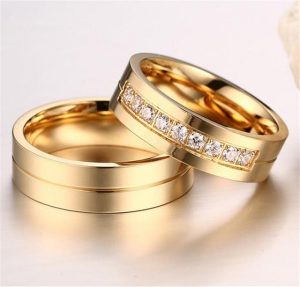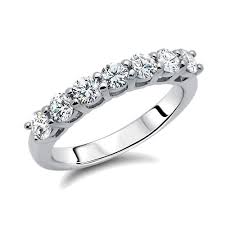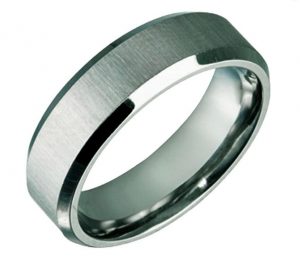Wedding rings are available in a wide range of different metals, each with their key advantages and disadvantages.
These include yellow and white and in different karats, as well as precious metals like platinum. Some wedding bands are also available in alternative metals, such as titanium and tungsten carbide.
With so many different options available from splurge-worthy platinum to classic gold to budget-friendly tungsten, it can be a bit confusing to determine the right type of metal for your wedding and engagement rings. I’ve compiled key metals to help you make the right choice!
Kindly see below, In order from the most expensive to the least:
Platinum
Platinum is considered to be the “most precious” of all precious metals — it’s rarer than gold and, as a result, costs more. It’s usually mixed with other similar metals, known as the platinum group metals: iridium, osmium, palladium, rhodium and ruthenium. Platinum is extremely dense and much heavier than gold or silver, giving it a remarkably high level of durability — it doesn’t wear or tarnish like other metals, and it’s not susceptible to problems like stress-cracking or corrosion that can plague white gold. But without regular cleaning, its white appearance can develop a hazy patina over time. Caring for a platinum ring couldn’t be easier, though — just soak in a mix of mild soap and warm water, and then gently rub it with a soft brush. And although platinum is scratch-resistant, it’s not scratch proof — but scratches can easily be removed by buffing.
Why choose this metal: Although platinum costs more, it requires less maintenance over time.
Gold
The first decision is whether you want 9KT and 18KT gold. The “KT” refers to “karat,” a measurement which is used to describe the purity of gold. Karats indicate the amount of gold as a percentage of the total — 24 karat gold is 100% pure gold. 18 karat gold, used in most European jewellery, is 18 parts gold and 6 parts other metals (75% pure gold). 9 karat gold contains 37.5% pure gold (375 parts per thousand parts).
Pure gold is too soft for jewellery-making. The additional metals — called alloys — improve the strength and hardness, in addition to corrosion resistance, colour, and workability.
The next decision: yellow gold or white gold? In yellow gold, the most commonly-used alloy metals are copper, silver and zinc. In white gold, additional white metals (nickel, manganese and palladium) are added to achieve the silver/grey shade. Palladium and nickel act as primary bleaching agents for gold, creating the warm grey tone. Also, white gold is usually plated with rhodium to give the same look like platinum. Keep in mind, though, that rhodium plating will wear off over time, and the white gold will take on a yellow cast. White gold jewellery needs to be re-plated every few years to maintain their whiteness.
Why choose this metal: Yellow and white gold are traditional, popular and widely available. Although rings made of yellow gold may show scratches and other abrasions, repairs and maintenance are easy. White gold costs more than yellow, and you’ll need to keep in mind the additional upkeep for white gold rings.
Sterling Silver
Sterling silver is the whitest of all metals. Like pure gold, 100% fine silver is too soft for most jewellery applications. Sterling silver, the industry standard, is a mixture of 92.5% silver and 7.5% metal alloy (look for the standard quality stamp 925, which indicates 92.5% purity).
Rhodium plating is often added to sterling silver to enhance surface reflection and protect tarnishing. This occurs when silver reacts with sulfur in the air (sulfur is found in wool, rubber bands, some types of paint, latex gloves, and more). With rhodium plating — and proper care — sterling silver jewellery can maintain a polished, shiny look for years before experiencing any tarnishing.
Why choose this metal: Sterling silver jewellery has become a popular trend. It’s much more affordable than gold, and the rhodium plating it gives the look and shine of platinum or white gold. With careful maintenance, sterling silver jewellery can last for many years to come.
Titanium
Titanium is a silver-hued metal that is lightweight and strong at the same time. The advantage of a titanium wedding ring is that it’s highly resistant to corrosion. If you’re in a water-related profession where you’re consistently in contact with seawater and/or chlorine, Titanium will withstand those damaging elements.
Why choose this metal: Highly recommended for those in water professions, titanium is considered to be the most corrosion-resistant metal. It’s also budget-friendly! One caveat: Titanium is difficult to resize
Tungsten
Tungsten is a very hard metal with grey colour in pure form. Such rings are popular among men for the grey metal look, affordable price, designer style, and durability. They’re dense, scratch-proof, and require little maintenance. Tungsten carbide rings can also be plated in gold or black. One caveat: Being a very hard metal makes tungsten brittle — it can shatter on high impact.
Why choose this metal: It is perfect for the rugged types who don’t want to worry about damaging their ring. The biggest drawback is that this type of metal cannot be resized at all.
All these metals are available at CLAYTESSS JEWELLERS
This post originally appeared on tessthejeweler.wordpress.com








